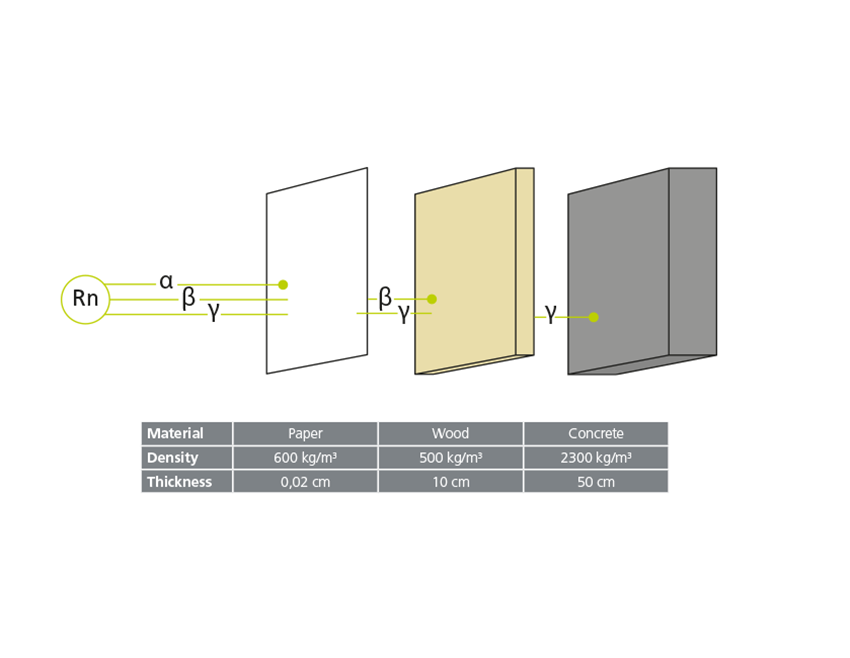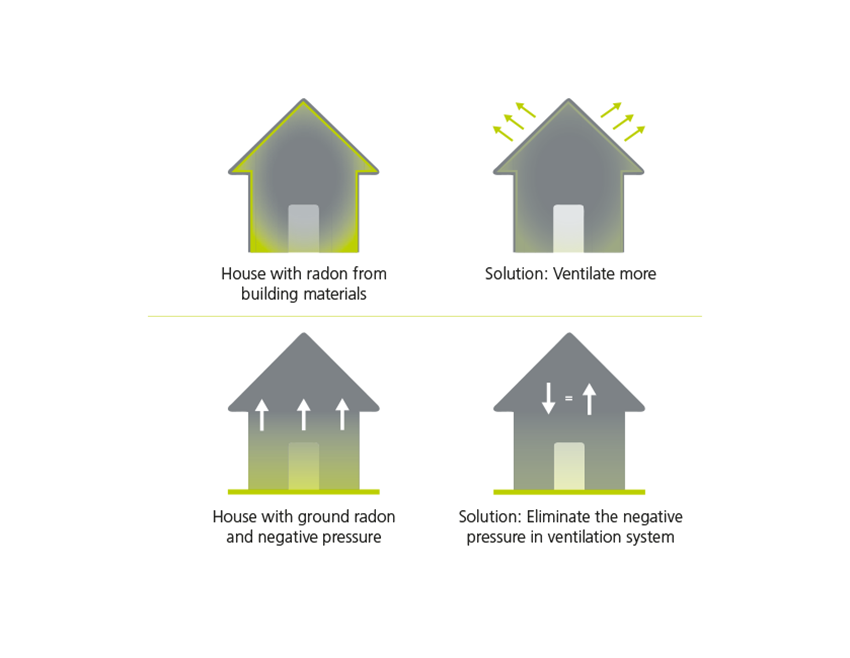Radon in homes
Radon is a noble gas that can be neither seen nor smelled. But high-dose exposure to this radioactive substance is a serious health hazard. To prevent elevated levels of radon in indoor air, there are a number of effective safeguards. The main thing is to ensure that the ventilation is adequate.
Radon and types of radiation
Radon is an invisible, odourless noble gas that enters homes in construction materials, domestic water and from the ground. This gas cannot be detected by ordinary gas chromatography, but is measurable because it is radioactive. Radon is the second-most common cause of lung cancer after smoking. In Sweden, if the radon content of all buildings measured as having a radon level exceeding 200Bq/m3 is reduced, we will ultimately be able to prevent around 200 lung cancer cases a year.
Types of radiation
- Alfa (α)
- Beta (β)
- Gamma (γ)


Where does the radiation come from?
How does radon enter a building?
Construction materials
The indoor radon content depends on activity (radium content) in walls, the airtightness of walling material, surface airtightness, the volume of the indoor space, indoor air change rate, air pressure, etc.
Domestic water
Ground water that mixes with water containing radium absorbs radon. Radon in domestic water is given off when water is run. This means that the radon content when we take a shower increases significantly. For municipal water, there may be no problem, but for properties served by a private well, the water may need to be aerated before it enters the building.
Ground radon
Radon gas may be sucked into a building from the ground beneath the property. With negative pressure in a ventilation system, the risk of radon infiltration increases.
Radon gas in buildings is the no. 1 radiation source, but is also the factor that we can do most to manage!Ingemar Samuelson, RISE Built Environment, Research Institutes of Sweden
Is the radon content in your indoor air elevated?
The Nordic countries, for example, have some of the highest indoor radon levels in the world, meaning a value exceeding 200 Bq*/m3. In order to detect and safeguard all radon-affected homes, measurements are needed in virtually all detached houses and apartments with ground contact or constructed using pre-1975 aerated concrete.
The usual method of measuring radon in indoor air is by means of small track-etch detectors. This makes measurement easy to accomplish. Obtaining radon content measurement in a single or two-storey building costs EUR 20-50. The measurement must be done during those times of the year when the home is heated; in the Nordic countries from October until the end of April. The measurement must be for at least two, ideally three months, to obtain an annual mean value. The occupants carry on their lives as usual for the duration of this long-term measurement.
In regions like the Nordic countries, radon content should be measured:
- When buying a home
- When building, converting or extending a detached house
- If the house is sited (or suspected as being sited) in an area with
high levels of ground radon or, built from materials that emit radon such as pre-1975 aerated concrete
- When modifying a ventilation or heating system
Eliminating radon: what works?
Ventilate more
If radon gas is emitted by structural materials in the building, and from these only, doubling the rate of ventilation halves the radon concentration.
Balance the ventilation system
For protection against ground radon, you need a balanced ventilation system, meaning the same amount of mechanical supply air as extract air. If there is negative pressure, the risk is that the radon will be ‘sucked’ into the building through cracks in the foundation. The solution for most homes is to install an air-to-air heat exchange ventilation system for venting spent, radon-contaminated air.
More about air-to-air heat exchange ventilation systems
SIEVERTS
1 sievert (Sv) is defined as high-dose radiation, and is borderline for severe harm to human health. Smaller units of measurement are usually used: millisieverts (mSv) = a thousandth of one sievert and microsieverts (μSv) = a millionth of one sievert.
RADIATION DOSE
The radiation dose is the measure of energy transferred to an irradiated object. Sieverts are used for measuring the dose-equivalent (absorbed energy per unit of mass) and effective dose-equivalent (the differing sensitivity of bodily organs per unit dose-equivalent).